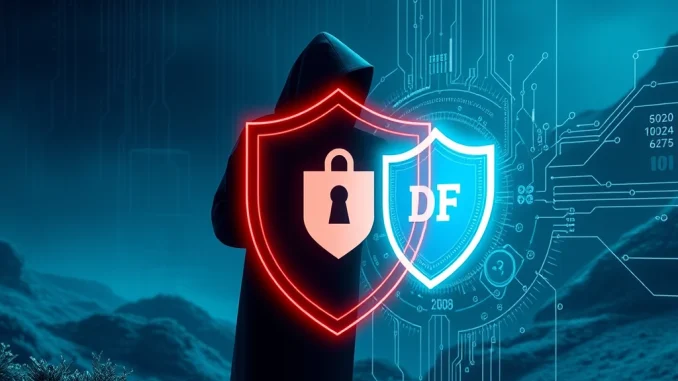
In a stark reminder of the ever-present threats in the crypto space, popular DeFi asset management platform Zapper has issued an urgent warning to its users. The platform disclosed a sophisticated social engineering attack targeting its zapper.fi domain. This incident underscores the critical importance of DeFi Security and vigilance in the Web3 realm. Are your digital assets safe? Let’s delve into the details of this concerning Zapper Domain Attack and what it means for you.
What Happened? Unpacking the Zapper Domain Attack
Zapper, a widely-used platform that simplifies the management of decentralized finance (DeFi) assets, alerted its community via X (formerly Twitter) about a security breach. Here’s a breakdown of the key points:
- Social Engineering Attack: The attack was executed through social engineering, targeting Netim, Zapper’s domain provider for the
.fidomain. Social engineering involves manipulating individuals to divulge confidential information or grant access to systems. - Domain Compromise: The
zapper.fidomain was compromised. While the exact nature of the compromise wasn’t immediately detailed, Zapper warned users against visiting or clicking any links associated with this domain. - Official Domain: Zapper emphasized that its official and secure platform should only be accessed through
zapper.xyz. This clarification is crucial for users to avoid falling victim to phishing attempts or malicious redirects.
This incident serves as a powerful example of how even well-established platforms in the DeFi Platform space can become targets of sophisticated attacks. It’s not just about smart contract vulnerabilities; the attack vector here is the domain itself, a foundational element of web presence.
Why is This a Big Deal for Web3 Security?
The Zapper domain attack highlights several crucial aspects of Web3 Security that users and developers need to be acutely aware of:
- Beyond Smart Contracts: Security in Web3 extends far beyond just the code of smart contracts. Domain names, DNS management, and domain registrars are critical infrastructure components that can be exploited.
- Social Engineering Risks: Humans remain a significant vulnerability in any security system. Social engineering attacks exploit human psychology to bypass technical defenses. This incident demonstrates that even service providers are susceptible.
- Trust in Domains: Users often rely on domain names as a primary indicator of website authenticity. When a domain is compromised, this trust is undermined, making it easier for malicious actors to deceive users.
- Rapid Communication is Key: Zapper’s swift communication via social media platforms like X is commendable. In the fast-paced world of crypto, immediate alerts can significantly mitigate potential damage.
[img] [/img]
Protecting Yourself from Domain-Related Crypto Threats
So, what can you do to safeguard yourself against similar Crypto Security threats and domain-related attacks? Here are some actionable steps:
- Verify Official Channels: Always double-check the official domain of any crypto platform you use. Bookmark the correct URLs and be wary of links from unverified sources. In Zapper’s case,
zapper.xyzis the confirmed safe domain. - Be Skeptical of Links: Exercise extreme caution when clicking on links, especially those related to your crypto accounts or wallets. Phishing attacks often use deceptive links to steal credentials.
- Enable 2FA Everywhere: Two-Factor Authentication (2FA) adds an extra layer of security to your accounts. Enable it wherever possible, including domain registrar accounts if you manage your own domains.
- Stay Informed: Keep up-to-date with security news and alerts from the crypto platforms you use and from reputable crypto news sources. Platforms like Zapper often use social media to disseminate urgent information.
- Use Security Extensions: Consider using browser extensions that help detect phishing attempts and malicious websites. These tools can provide an additional layer of defense.
The Broader Implications for the DeFi Ecosystem
The Zapper domain attack is not an isolated incident; it’s symptomatic of the broader security challenges facing the rapidly evolving DeFi ecosystem. As DeFi continues to grow and attract more users and value, it becomes an increasingly lucrative target for cybercriminals. Here’s what this means for the future:
| Challenge | Implication | Potential Solution |
|---|---|---|
| Sophistication of Attacks | Attackers are becoming more sophisticated, employing tactics like social engineering and supply chain attacks. | Enhanced security protocols across the entire Web3 infrastructure, including domain management and registrar security. |
| User Education Gap | Many users, especially newcomers to DeFi, may lack the security awareness needed to navigate these risks. | Increased focus on user education and awareness campaigns by platforms and the crypto community. |
| Centralization Risks | Reliance on centralized domain registrars introduces potential points of failure and attack vectors. | Exploration of decentralized domain name systems (DNS) to reduce reliance on centralized entities. |
| Regulatory Scrutiny | Incidents like these may attract greater regulatory attention to the DeFi space, potentially leading to stricter compliance requirements. | Proactive adoption of security best practices and industry standards to build trust and demonstrate responsible innovation. |
Conclusion: Staying Vigilant in the DeFi Landscape
The Zapper Domain Attack serves as a critical wake-up call for the entire crypto community. It underscores that DeFi Security is a multifaceted challenge that extends beyond code vulnerabilities to encompass domain infrastructure and human factors. As users, it’s our responsibility to stay informed, remain vigilant, and adopt proactive security measures to protect our digital assets. Platforms like Zapper play a vital role in providing tools and services for navigating the DeFi space, but ultimately, security is a shared responsibility. By prioritizing Web3 security best practices, we can collectively build a more resilient and trustworthy decentralized future.



